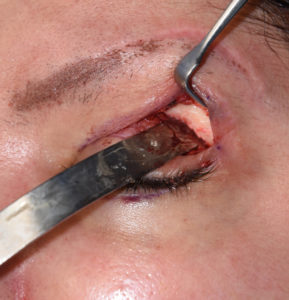Brow bone reduction is a well known aesthetic procedure for reducing the horizontal projection of the lower forehead. Done by either burring for minor changes or an osteoplastic bone flap setback technique for more major setbacks, the horizontal position of the brow and/or its convex shape can be reduced. But no matter what brow bone reduction method is used, it almost always requires an open approach through a hairline or coronal scalp incision.
But the horizontal reshaping of the brow bones is not the only dimension in which it can be changed. Vertical brow bone reduction can also be done. This may be performed when the brow bone is sitting too low into the orbit, particularly the tail of the brow bone. This may be indicated in reducing the exposed or skeletonize brow bone after a browlift, for a congenitally short orbital height, in vertical orbital dystopia to even out the superior orbital rims or to try and increase the vertical opening of the eye.

Transpalpebral brow bone reduction is largely about reshaping the outer half or tail of the brow bone. The upper eyelid offers both direct and good aesthetic access to perform it.
Dr. Barry Eppley
Indianapolis, Indiana


